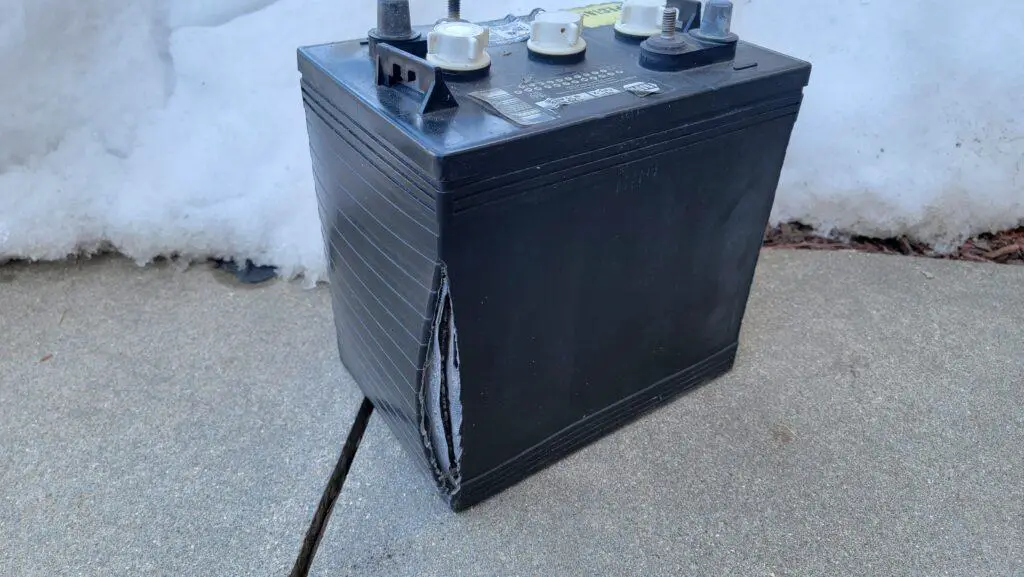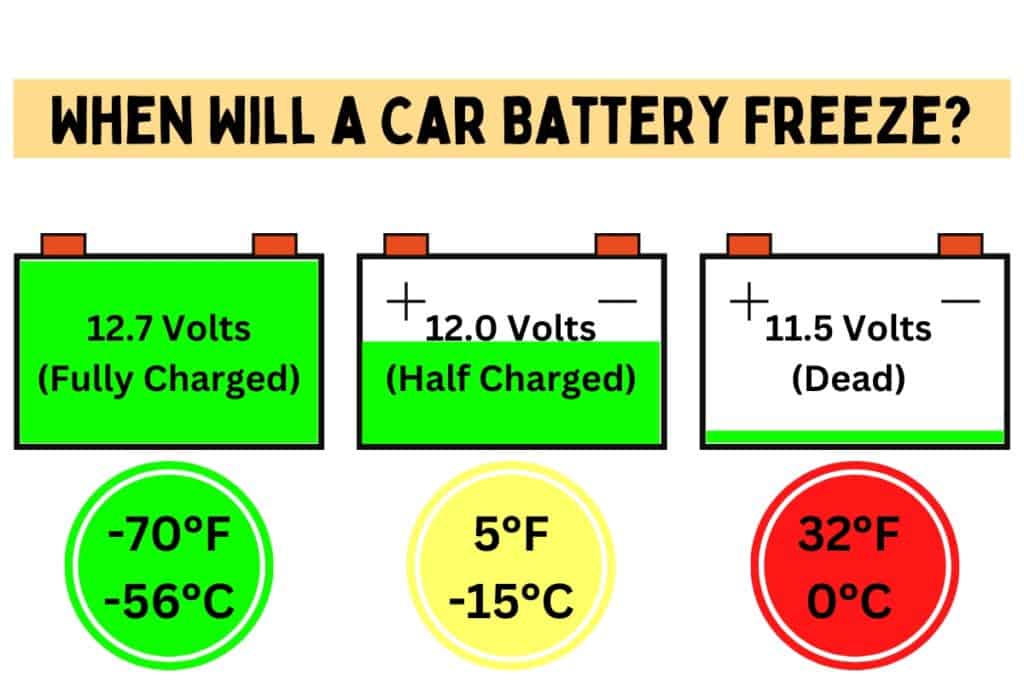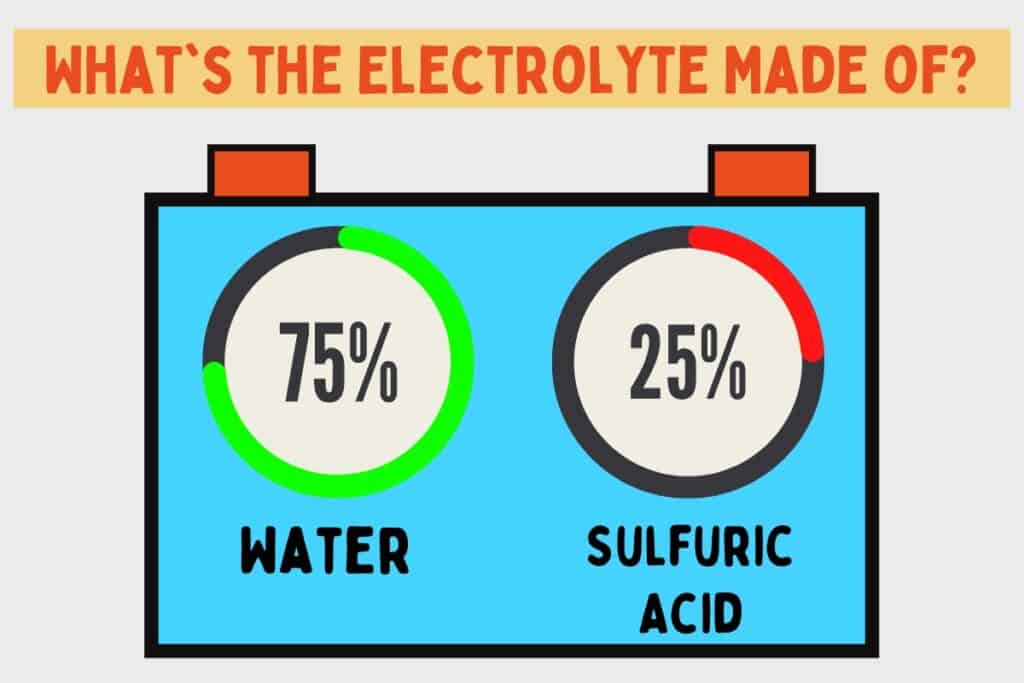You just got love waking up in the morning and trying to turn your key in the ignition only to hear a struggling battery or nothing at all. Welcome to winter and freezing temperatures!
Sure, the cold can make your car battery work harder, but can it really freeze the battery itself? There’s acid in there, right? It shouldn’t freeze, should it?
A car battery will freeze if its state of charge and the temperature are low enough. A fully charged battery at 12.7 volts will freeze at -70°F. A half-charged battery (12.0 volts) can start freezing at 5°F and a fully discharged car battery (11.5-volts) will freeze at 32°F.
In this article, I’ll touch on why a car battery freezes, if your car battery will be ruined by freezing, and what you can do to prevent this from happening in the first place.

Why Car Batteries Freeze
Like I briefly mentioned above, car batteries are perfectly capable of physically freezing which means that they can turn into ice inside of the individual cells of the car battery. The electrolyte solution, which is 75% water and 25% sulfuric acid, will change its freezing point properties dependent upon the state of charge of your battery.
Think of it like freshwater being a fully discharged battery and completely saturated salt water being a fully charged battery. The freshwater will freeze at 32 degrees Fahrenheit, and the fully saturated salt water will freeze at -6 degrees Fahrenheit. The more salt you take out of the salt water (charge, in the battery’s case), the higher the temperature that it will freeze at, just like with a battery.
A fully charged car battery will get you down to about -50 to -70 degrees Fahrenheit (-45 to -56 Celcius) or maybe a little bit more before your car electrolyte is at risk of turning to ice. A fully discharged battery can freeze at around 32 degrees Fahrenheit (0 degrees Celcius).

For most of us, the problem really occurs during the winter when we have a car battery that is not fully charged and is in a constant state of partial charge. A fully discharged battery can freeze right at or around 32゚F which is the freezing point for fresh water.
A fully charged car battery will measure about 12.7 volts with a voltmeter. A car battery measuring 12.0 volts (which is about 50% charged), will freeze around 5 degrees Fahrenheit.
You can check out a great piece on the actual freezing temps based on the charge of a car battery here.
A lot of this really depends on the age and state of health of your car battery and how well you’ve maintained it over the years.
Also, keep in mind that inside your car battery you have 6 separate cells within it. You might have 5 cells that are in great working order and one that is weak and never holds a full charge and that one defective cell could freeze before the other ones.
Another thing to keep in mind is that when your car is very difficult to start in cold weather, not only is the battery struggling to release its cold-cranking amps (CCA) (because cold temperatures increase internal resistance), but your oil is thicker than it normally is and it’s harder for your car to mechanically startup. Remember, the pistons need to start moving within the cylinders and they need lubrication.

Tools to Prevent A Car Battery From Freezing
Combining a heated silicone car battery mat with a thermostatically controlled outlet as well as an easy to install oil pan heater like these seen on Amazon is a great way to ensure that your car will be as easy to start as possible in severely cold temperatures.
After install, you simply run an extension cord over to your car and plug in the thermostatically controlled outlet first as a medium between the wall cord and the car heaters. Then plug the heaters into the two receptacles on the outlet.
The outlet is specifically designed to only engage the heaters when the temperatures get too cold, and then it shuts off again when the temperatures warm up. That way you’re only heating your battery and oil pan when necessary. It’s a simple “set it and forget it” process, you just need to remember to plug it in every time you arrive home.
If you suspect that your battery isn’t getting a proper charge based on your driving habits (short commutes kill a car battery), then I recommend this battery charger that has a quick disconnect feature so you can leave the ends of the charger permanently connected to the battery and simply disconnect the charger with a simple clip when you’re ready to leave.
I’ve used this charger for over 5 years and it’s great! It will fully charge your battery in 8-10 hours from a full discharge and it can be hooked up indefinitely without harming your battery.
Your Habits Cause a Car Battery to Freeze
Cold temperatures are obviously the primary reason why your car battery freezes but as we talked about before, the state of charge really has everything to do with whether or not your battery will freeze for all practical intents and purposes.
The higher the charge on your battery, the colder the temperature it can withstand. Believe it or not, driving habits are probably the number one factor with the state of charge of your battery.
Every time you start your car, especially in cold weather, more energy is drained out of your car battery and needs to be replenished by the car’s alternator. If you drive around in the winter to run errands and start your car 5 or 6 different times to go to 5 different locations and never drive your car for more than a few minutes at a time before returning home, then your car battery might be at a 90% charge (assuming you started at 100% in this example).
Do this for a few days and combine it with the parasitic draw that happens when your car isn’t even running from the clock radio and the anti-theft system and your charge is dropping even more. You can see how you could get down to a 50% state of charge really quickly. Don’t be surprised if your car battery freezes on one of those nights and gives you a bad morning to wake up to.
Is a Car Battery Ruined if it Freezes?
If a car battery simply gets really cold but doesn’t physically freeze, then it’s not going to experience much damage at all physically. It’s just harder for the battery to accept a charge from a charger or give off electricity when you turn the key. The car battery simply acts sluggish.
You’ll probably notice this when you take your cell phone out and hold it in your hand in cold temperatures during the winter. You’ll notice your phone battery percentage drops exponentially fast. It’s not that the phone battery actually lost its charge that fast, the phone just doesn’t recognize the charge because it can’t pull current from the battery as quickly due to the cold and it appears to the sensors in your phone that the battery is more dead than it really is.
Warm-up your phone again and when plugged into a charger and you’ll notice that it charges really quickly because there isn’t much to actually charge.
Now, if a car battery actually physically freezes and turns to ice within the cells, then yes, your car battery can be irreparably damaged and more than likely you’re going to want to invest in a new battery. I would not trust a car battery that has physically frozen to remain under the hood of my car.
Remember that when water freezes it expands, and inside your car’s battery you have a bunch of thin lead plates and 6 cells that house those plates that are pressed together very tightly with not much wiggle room whatsoever.
When ice crystallizes and expands it will push those lead plates into each other it will push out against the walls of the battery itself and make it bulge it will push the cells into each other and maybe even rupture them. The odds of your battery shorting out internally and never holding a proper charge again are very high if your battery has been allowed to fully freeze and turn to ice.
How Can You Tell if Your Car Battery is Frozen
A visual inspection is obviously the easiest way to tell if your car battery is frozen. Of course, you’re going to want to wear safety glasses whenever dealing with a 12-volt car battery (especially if it’s a flooded type with the removable caps for checking the electrolyte).
Check the sidewalls of your battery first and see if they’re bulged out. If they are, this is a clear indication that ice has expanded within your cells and is pressing out against the walls of your battery. But also make sure that you’re properly linking the bulging walls of your battery to the cold weather. Your battery can have its walls bulge out from a long overcharge as gasses can’t escape fast enough which can happen if you don’t use a proper smart charger.

You can also disconnect your battery and slosh it around and listen for any liquid inside. This is especially true if you have a flooded lead-acid battery and you should be able to hear the electrolyte splashing around. If you don’t hear it, then it’s more than likely frozen.
If you have a flooded lead-acid battery, you can also pop the caps on top to check the battery acid inside and you can visually inspect with a flashlight to see if there’s ice.
Is It Safe to Charge a Frozen Battery
It is NEVER safe to charge or try to jump a car battery that has ice inside of the cells. You risk an explosion by doing this.
Most quality smart chargers have microprocessors that will first try to detect a base voltage from your battery before they even start pumping out a charging current. More than likely, if there’s an issue with ice in your battery, they won’t even start the charging process. Still, it’s not worth risking it.
Older chargers that don’t have this safety feature of first detecting a base voltage from the battery will pump out a charging current regardless and this can lead to an explosion. The same thing applies to using jumper cables from another car’s battery and alternator which are going to pump out a current regardless of whether or not your battery (which is frozen) can accept.
If your car battery has frozen to the point where the walls are bulging out, I would not even risk trying to charge it even after thawing it out inside.
If you do not see any external structural damage to your car battery and you knew that there was some ice inside of it (but are not sure if it completely froze), then it might be worth trying to give it a charge after it is completely thawed out. Monitor the charge closely, and I recommend having a digital voltmeter connected at all times so that you can see the state of charge as you go.
When done, disconnect the charger, and wait a couple of hours before you check the voltage, and use a hydrometer to check the specific gravity of each of the cells to see if they are actually still holding a charge. If you have a sealed battery then you will be unable to do this last step with the hydrometer and you’ll just have to use a voltmeter to test the open voltage between the positive and negative terminals to get the best guess from home without subjecting it to an actual load test.
You could always take your battery to an auto mechanic and have them perform a load test on your battery to see its overall health.
How to Prevent your Car Battery from Freezing
[Links to my recommended products for preventing a frozen car battery are near the top of the article.]
Being proactive with preventing your car battery from freezing is definitely the best approach if you live in a cold climate or an area that experiences severe winters.
A car battery blanket or pad is designed to provide a thermal barrier between the cold weather and your car battery and generates a small amount of heat that will keep your battery ready for releasing enough cold cranking amperage to start your car battery with ease.
Like we mentioned before, don’t forget about your oil. Just because your car battery is kept the warm and can release enough cold cranking amps doesn’t mean that your car will mechanically want to comply — especially as the oil thickens with the colder temperature.
Make sure you have the correct winter weight oil for your vehicle. You can consult your owner’s manual for the recommended oil weights.
Consider installing an adhesive oil pan heater to keep your oil at an ideal temperature for starting in cold weather.
You can even go a step further and have a battery charger with quick disconnect cables that are permanently mounted on your car battery so you can charge your battery each and every night after you return home.
Finally, be mindful of your driving habits. If you drive 30 minutes into town and 30 minutes back, your battery is going to stay near a full charge if that is your usual habit. The short trips with multiple starts and stops of the ignition are what really drains a battery in no time.

